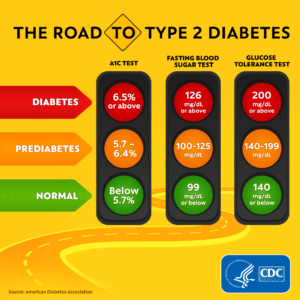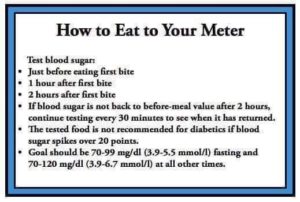This question is relevant if you’re not checking your blood sugar at all AND if you’re checking it 4 or more times everyday.
There’s a number of questions that come with checking your blood sugars that I want to address in this blog post:
Why do I need to check it?
What is a good reading? What’s a bad reading?
What kind of monitor should I get?
What do I do with my readings?
What time of day is best to check?
You might have been given clear instructions that address these common questions from your doctor. You might agree and you might disagree. Maybe you have a family member who has a strong opinion about when you should check.
What I want to do is give you the information you need to decide FOR YOURSELF what makes sense. Let’s start there.
What’s the point?
It’s a hassle and it’s painful. There better be a darn good reason to go through all the trouble to stab yourself, feed your blood into a machine, and keep a meticulous record of the results, right?
The answer to whether or not you need to do all this work is easy to find if you answer this question first:
What are you going to do with the information you get?
Are you going to use it to make decisions? Is your doctor going to use it to make decisions?
Checking your blood sugar in the moment gives you REAL TIME information about how your body responds to food, exercise, medications, among other things. Every time you check it, you could learn something about your body.
I’d say that’s pretty empowering.
It’s like doing an experiment where you get very individualized information about YOUR body and what it does or does not like. You might learn something from a stand-alone reading or you might need a trend to draw conclusions.
Once you know what happens when you eat this or that or whatever variable you are testing, you can make immediate adjustments to your lifestyle to get you results you are shooting for.
If you don’t know what the results mean and can’t use the information to make decisions, then it doesn’t make a lot of sense to go through the process of monitoring every day.
UNLESS, your doctor has asked you to bring the results to them for medication adjustments. Doctors make changes to medications based on trends in your blood sugar log.
If you don’t see your doctor doing this and you are checking four times a day, it’s logical to ask your doctor why the heck you need to check so much. They may have thoughtlessly put this burden on you without considering the same question we are discussing here.
And here’s a secret from someone who does this work with patients routinely: It’s really the last week or two leading up to your appointment that is the most important period to evaluate.
If you don’t like checking your sugars and you’re not using the information for anything, you don’t need to check everyday for months between your doctor appointments.
Is this number 👍 OR 👎 ? 🤷♀️
How can you use this information to your benefit if you don’t know what is a good or bad reading?
In general, there are 2 different groups of readings: fasting (no food or beverages for at least 8 hrs) and postprandial (2 hours after a meal).
If you are shooting for an A1c < 7%, which is a common goal that doctors want to see, this corresponds to a fasting blood glucose < 130, a postprandial < 180, and an average of 154.
If you want to eventually shoot for normal readings, here is what those look like:
There is one additional important reason to check your blood sugar that I want to mention here: to make sure you are not at risk for a very high or very low blood sugar event. Of these two, the very low readings are the most dangerous and require immediate attention.
A blood sugar < 70 is considered too low, or hypoglycemia, which is a medical emergency.
It requires prompt correction by eating about 15 gm (the amount of sugar in 4 oz of juice or soda) of easily absorbed sugar. If you are noticing you don’t feel well and think it could be your blood sugar, it’s a good idea to check it if you can and then act accordingly.
What kind of blood sugar monitor is the best?
The most expensive one! Just kidding.
It really isn’t that important what kind you get. For a lot of people, this decision is made by their insurance plan and their pharmacy’s inventory.
If you have a say, it might be nice to think about whether or not it will communicate with your smart phone, which is handy for downloading and transmitting results to your doctor or your computer.
For most people, the generic standard monitor is adequate.
If you don’t have insurance and cost is an issue, I recommend just picking up a Reli On meter at Wal-Mart because the test strips are very economical ($9 / 50 strips). These meters are so inexpensive (also $9 at the time of this post), you can even purchase 2 or 3 to leave in convenient places like your workplace and in your car.
I will mention that there is one kind of monitor in particular that has compelling advantages. This kind of monitor is called a continuous glucose monitor (CGM), and it will require a prescription.
Most brands (e.g., Dexcom, Medtronic) are costly and pretty much out of the question for those without insurance. However, one relatively inexpensive system, the Freestyle Libre, makes continuous monitoring a viable option for most people.
CGMs are an amazing tool because they do not require constant fingersticks to get information about what your sugars are doing. These rely on a sensor that stays in place (10-14 days depending on which brand) and transmits readings continuously.
This is a huge advantage. It gives you a steady stream of information about what your blood sugar is doing anytime you want to know PLUS what direction it is going in. So if you’re at 80 and it’s heading south, you can act before you get into trouble.
The Dexcom G6 has some features that the Freestyle Libre does not. It’s more accurate at lower and upper extremes, it has alarm features you can set to let you know when you’re really off track, and it does not require scanning for results.
The Libre offers the LibreLink mobile app that downloads to your smart phone, allowing you to use your phone as the scanner. If you can avoid buying the scanner, you can get away with 2 sensors per month for around $120 with a prescription.
If you’re wondering what’s going on with your blood sugar in the middle of the night, it’s so much easier to find out with a CGM. 😉
When is the best time to check?
Besides anytime you’re not feeling right, the absolute best time to check is when you are fasting. This becomes your baseline, your north star. It’s where you are starting off the day.
Of course, once you eat, the situation changes. Especially if you eat like most Americans, with a lot of variety and frequently throughout the day.
If you are just trying to get an idea of what is going on, I encourage you to check as often as you want to. If you are looking for patterns, which is what your doctor is looking for, you will want to check at consistent times of the day.
This typically looks like before breakfast (fasting), before lunch and dinner, and at bedtime. It’s hard to remember to check 2 hours after a meal, but this will tell you how quickly your body can process the carbohydrates you ate. If you are intolerant to carbs, you won’t be able to get back down before your next meal.
If you are wondering if it’s okay for you to eat a particular food, you can always test it out by “eating to your meter.” This is a method that allows you to learn what works for you.
Though these blood sugar ranges may not be everyone’s goal, as they align with a non-diabetic response to food, the idea is quite useful.
You can find out right now whether or not a certain food is going to mess you up by doing this experiment. It removes the guesswork. How handy is that?
Are you using your glucometer to beat yourself up?
This last question is maybe one of the most important questions to address.
Many of us check our blood sugar and then have an all out mental beat down when we get a result we don’t like.
We might use the number as evidence that nothing is working. That we’re doing it wrong. That we are going to die a slow and terrible death.
It might sound dramatic, but our brains are wired to focus on and exaggerate threats to our survival.
High readings can bring on feelings of guilt, shame, and despair. And it usually makes things much worse. I wrote about this in a past post How Beating Yourself Up With Your Thoughts Makes Your Blood Sugars Worse.
If you notice you are doing this, make sure to go and read the linked post above. It will help you take constructive action with your blood sugar readings rather than self-destructive action, like giving up and binging on food you KNOW is harmful to you.
Even though there is no substitute for knowing WHAT to do, getting yourself to do it can be the most challenging part. If you’re struggling with either the WHAT or the HOW, I’m your best ally. I can teach you both. I help you apply it, help you fail until you reach your goals, and equip you with all the tools you need to secure a future free from Type 2 diabetes.
Got more questions? Send them to me here:




